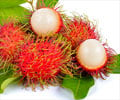Scientists at the Harvard Medical School have discovered a previously unidentified pheromone that contributes to the anti-aphrodisiac effects observed in female fruit flies after copulation.
In study, which has been published in Current Biology, Harvard Medical School (HMS) researchers, along with German colleagues, report on a newly discovered pheromone produced by male fruit flies. They found that the pheromone, which they named CH503 for its molecular mass, acts as the chemical equivalent of the "letterman jacket" when transferred to females during the mating process.CH503 remains on the female's outer body, warding off male suitors for at least a week. This anti-aphrodisiac effect helps to account for previously noted mating behaviors in fruit flies that have until now gone unexplained.
Researchers discovered this unexpectedly while using a new form of high-resolution laser mass spectrometry to scan distinct regions on the fruit flies' cuticle, or surface.
oanne Yew, at the time a postdoc in the lab of HMS Neurobiology professor Edward Kravitz, teamed with Klaus Dreisewerd and colleagues at the University of Münster for the study. They used the refined instrumentation, which allowed them to focus an ultraviolet, high-intensity laser on an area as small as 200 micrometers in diameter, to analyze and compare the chemical make-up of each discrete region.
The new technology allowed the team to view the flies at high spatial resolution for the first time, and led to the discovery of nearly 30 new compounds not previously detected by traditional methods.
According to Yew, the technology also revealed a difference in the pheromone profiles of the leg and genital regions of the fruit flies. Among the compounds they found almost exclusively in the male genital region was cis-vaccenyl acetate (cVA), which has long been known to work as an anti-aphrodisiac in fruit flies when transferred to females during mating. A second compound-the hydrocarbon they came to identify as CH503, was also discovered in the male genital region.
Mass spectrometry revealed that this newly discovered compound was passed on to females during copulation, and remained on the surface of their bodies for at least 10 days after successful mating.
This led the researchers to hypothesize that the new compound might be the missing piece to a longstanding behavioral puzzle: The anti-aphrodisiac effects of copulation have been observed to last for over a week in fruit flies, even though cVA only stays active on the female for 24 hours. To test their theory, Yew's team "perfumed virgin females with [CH503] and found that having this compound on the female's surface inhibited courtship in males."
Dr. Kravitz said of the findings, "Everyone already knew from behavioral experiments that the anti-aphrodisiac effects on female fruit flies can last up to a week, so it may be that this compound, CH503, explains why you have anti-aphrodisiac effects that last much longer. It also makes clear that cVA is only part of the story."
Source-ANI
SRM













